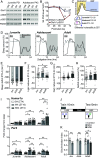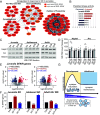Developing forebrain synapses are uniquely vulnerable to sleep loss
- PMID: 39441640
- PMCID: PMC11536182
- DOI: 10.1073/pnas.2407533121
Developing forebrain synapses are uniquely vulnerable to sleep loss
Abstract
Sleep is an essential behavior that supports lifelong brain health and cognition. Neuronal synapses are a major target for restorative sleep function and a locus of dysfunction in response to sleep deprivation (SD). Synapse density is highly dynamic during development, becoming stabilized with maturation to adulthood, suggesting sleep exerts distinct synaptic functions between development and adulthood. Importantly, problems with sleep are common in neurodevelopmental disorders including autism spectrum disorder (ASD). Moreover, early life sleep disruption in animal models causes long-lasting changes in adult behavior. Divergent plasticity engaged during sleep necessarily implies that developing and adult synapses will show differential vulnerability to SD. To investigate distinct sleep functions and mechanisms of vulnerability to SD across development, we systematically examined the behavioral and molecular responses to acute SD between juvenile (P21 to P28), adolescent (P42 to P49), and adult (P70 to P100) mice of both sexes. Compared to adults, juveniles lack robust adaptations to SD, precipitating cognitive deficits in the novel object recognition task. Subcellular fractionation, combined with proteome and phosphoproteome analysis revealed the developing synapse is profoundly vulnerable to SD, whereas adults exhibit comparative resilience. SD in juveniles, and not older mice, aberrantly drives induction of synapse potentiation, synaptogenesis, and expression of perineuronal nets. Our analysis further reveals the developing synapse as a putative node of convergence between vulnerability to SD and ASD genetic risk. Together, our systematic analysis supports a distinct developmental function of sleep and reveals how sleep disruption impacts key aspects of brain development, providing insights for ASD susceptibility.
Keywords: development; phosphoproteome; proteome; sleep; synapse.
Conflict of interest statement
Competing interests statement:The authors declare no competing interest.
Figures




Update of
-
Developing forebrain synapses are uniquely vulnerable to sleep loss.bioRxiv [Preprint]. 2024 Apr 12:2023.11.06.565853. doi: 10.1101/2023.11.06.565853. bioRxiv. 2024. Update in: Proc Natl Acad Sci U S A. 2024 Oct 29;121(44):e2407533121. doi: 10.1073/pnas.2407533121. PMID: 37986967 Free PMC article. Updated. Preprint.
References
MeSH terms
Grants and funding
LinkOut - more resources
Full Text Sources

